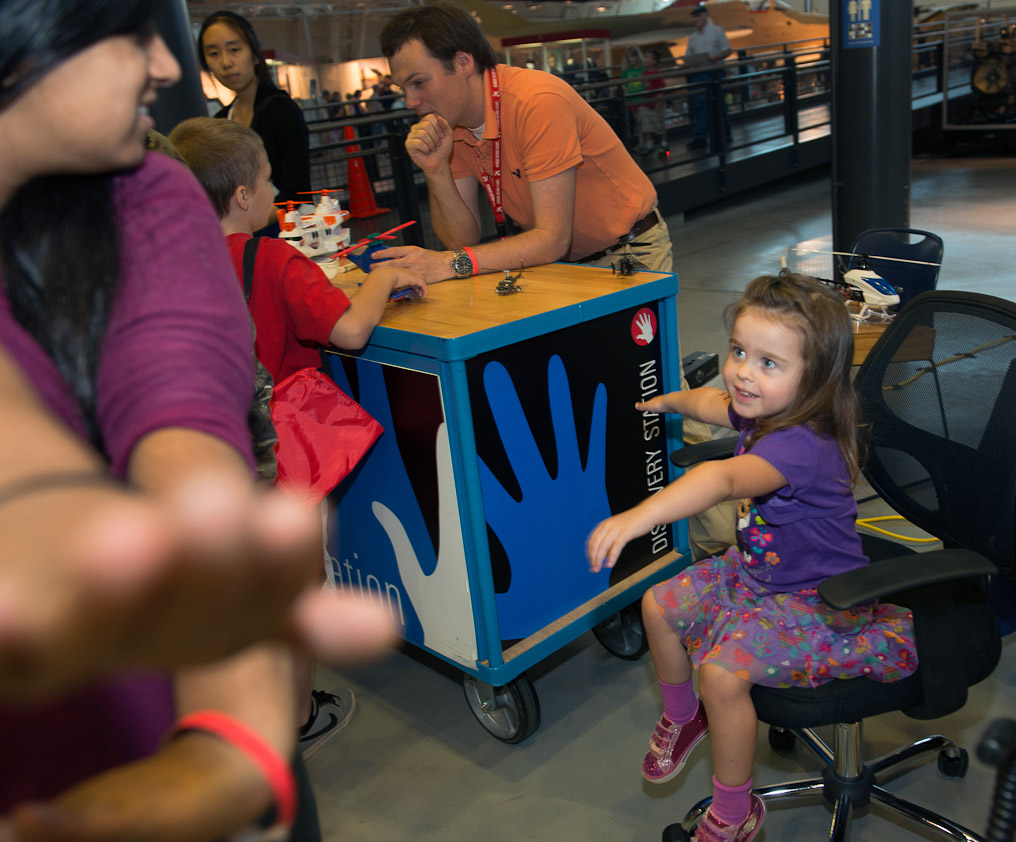Education Intern Soars

Smithsonian Intern Suthri Poduval (left) teaches a young girl about helicopters at the museum’s Super Science Saturdays. Photo by Mark Avino.
Smithsonian intern, Surthi Poduval, spent her summer interning with the Smithsonian National Air and Space Museum (NASM).
During her internship, Suthri helped plan events at the museum, such as Become a Pilot Day and Super Science Saturdays. She had the opportunity to meet the first Hispanic astronaut and the first female chief scientist at NASA, France Cordova.
Suthri tells us about her internship experience here…
I had already fallen in love with working at the National Air and Space Museum Udvar-Hazy Center in Chantilly, VA even before my internship. As a previous volunteer and Explainer there, I worked with kids and taught them about basic (and sometimes not so basic) scientific principles. I loved inspiring the visitors to learn more about science. I was motivated to apply for an education internship in order to further that interest, because as an intern, I would be able to do much more than my previous positions. This past summer, I had the opportunity to implement my own ideas, such as designing various activities and design challenges that explored topics such as “How do we get different types of precipitation?” to “How can we build a community on Mars?”
During my internship, I also helped plan events at the museum, such as Become a Pilot Day and Super Science Saturdays. Before, when I was a volunteer and an Explainer, I didn’t have a very good grasp on what happened behind-the-scenes to make the event work. However, as an intern, I learned fairly quickly about the various components that had to come together to make the day successful. We needed to bring together volunteers, exhibitors, and staff to work seamlessly together and ensure that we were delivering the best possible experience for the public with our resources and expertise. To help plan and execute the event, I worked on my communication skills through communicating with exhibitors to come to the events and by working with others at the museum, finding out how much coordination it takes to pull off an event. I also organized physical resources and helped to get materials necessary for the event, learning about the various needs of the museum and the administrative processes that are necessary to make things happen.
This experience has been thoroughly gratifying, as I’ve had opportunities given to me that I might not have ever received if I hadn’t taken this internship. I have had the chance to meet some really fascinating and inspiring people. I got to meet with the pilots of Solar Impulse, the solar plane that recently flew across the entire U.S., and learned much from them about the plane and the plans they have for Solar Impulse. During my internship we also worked with the Smithsonian Latino Center on a project called Young Ambassadors, and through that association I had the opportunity to meet the first Hispanic astronaut and the first female chief scientist at NASA.
While meeting people was a highlight, I also developed my writing and education skills by receiving positive feedback and tips from my supervisor who is a certified teacher and has worked for the Smithsonian for over 15 years. Just as importantly I was able to test my activities with visitors and groups who have experienced the activities I created. When I explained the photovoltaic activity that I helped to create, I had visitors come up to me and thank me for explaining the topic so well that even their four year-old kid understood the basics of how photovoltaic cells work. When I did a design challenge about building a community on Mars with 20 recent high school graduates from the Smithsonian Latino Center, they were pleasantly surprised to find that science and engineering subjects could actually be turned into fun activities! One participant said that he “never knew that engineering could actually be fun,” and several of his peers agreed, showing me how these activities had changed their perspectives to appreciate STEM fields as something that is not merely dry and purely academic. When I heard this statement, I couldn’t help smiling and saw that smile reflected in my co-workers. It was the feeling of success, knowing that the hard work we put in had helped open minds to new possibilities for their futures. I knew going into the experience that reaching out to more people and sparking an interest in science and engineering is exactly why I wanted the internship. After having had such a great experience, I’m eager to continue volunteering at the museum even after my internship and I hope that my future will hold more opportunities to continue to interest people in STEM fields.






